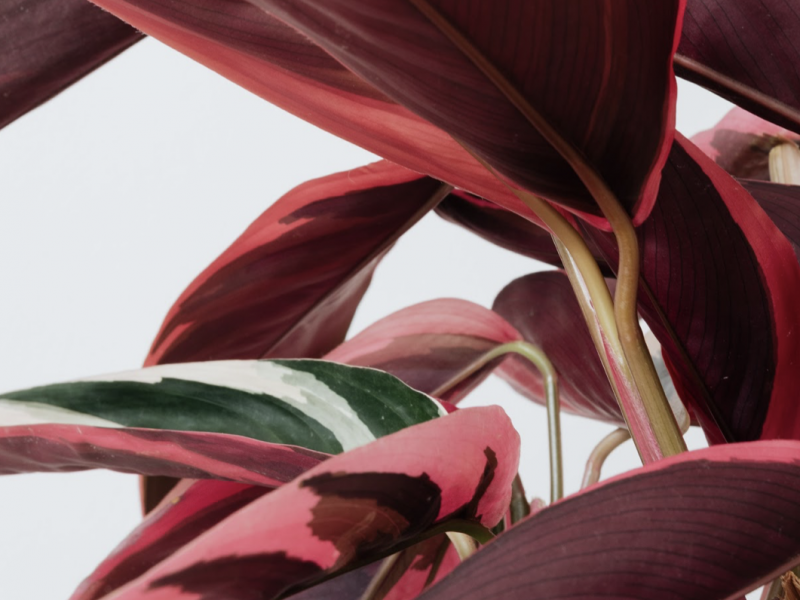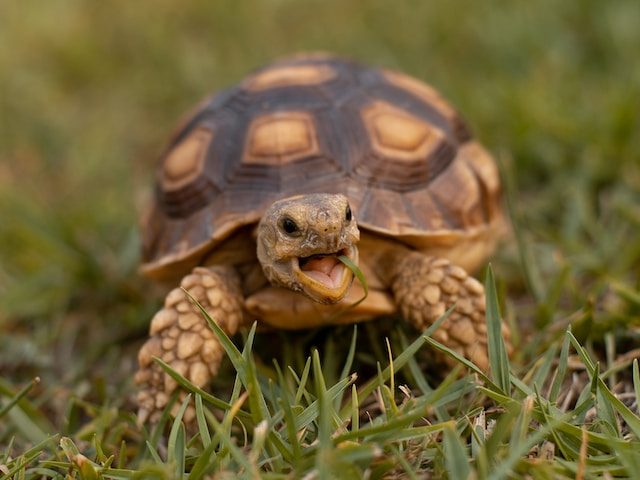
Known for their incredible colourful leaves, Calathea Triostar plants aren’t always the easiest to take care of. They can be quite fussy when it comes to curling or brown leaves but when you get the care right, it’s really worth it. However, one thing that is super easy when it comes to Calathea Triostars is propagation. We have written this propagation guide to give you all the information you’ll need to propagate your Calathea Triostar.
Below you’ll find a step by step process, as well as what tools and equipment are needed, what problems you might face and how to fix them as well as all of our top tips to help you propagate your Calathea Triostar successfully.
Why propagate your Calathea Triostar?
Before we get into the individual steps required to propagate your Calathea Triostar, we thought it would be useful to go through the reasons why plant parents might want and need to propagate it. The main reason is simply wanting to multiply the number of plants you have without actually having to buy any more. Who can say no to free Calathea Triostar plants?! Calathea Triostar cuttings and young plants also make great gifts for friends and family.
The other main reason why plant parents might choose to propagate their Calathea Triostar is because their plant is becoming too big for the space and they need to prune it. But instead of simply throwing away those beautiful Calathea Triostar cuttings, why not propagate them and start a whole new mother plant.
You might also end up not having a choice but to propagate your Calathea Triostar if it is showing signs of distress and unhappiness. We always recommend you try and figure out what is causing the issue but if nothing seems to be getting better then you might need to propagate part of the plant to save it. Just make sure that the part of the plant you are propagating is healthy as any issues will transfer onto the young new plant.
What tools/equipment will I need to propagate a Calathea Triostar plant?
Let’s start off with the easy part. It’s important to make sure you have all the right things before you start propagating your Calathea Triostar
Healthy and mature Calathea Triostar plant
Sharp scissors/shears
Spare pot(s)
Fresh soil and water
Newspaper or plastic sheet if you’re propagating indoors
What methods can be used to propagate a Calathea Triostar?
Unlike most other houseplants, you can only propagate your Calathea Triostar through division of the mother plant. This can be a problem if you have quite a young plant and don’t want to take such a large chunk from it. But the good thing about the division method of propagation is that it’s very successful and much quicker. Your new plant will already have quite a mature root system which makes them more robust.
How to propagate a Calathea Triostar through division of the mother plant
Take your Calathea Triostar out of its pot
To be able to propagate your Calathea Triostar through division, you’ll need to locate the various natural sections of the plant. Carefully take your plant out of the pot, shaking off the potting mix around the root system.
Locate the various offshoots in your plant
When looking for a part of the plant to divide it will become very obvious if there are various offshoots on your Calathea Triostar. They will have a separate root system and growth will stem from the middle of each section.
Separate the different sections
You should be able to carefully pull the various sections apart from each other. It’s ok if you have to slice around the plant a little to separate them but just make sure that each part of the plant has a substantial amount of the root system to aid a successful Calathea Triostar propagation.
It’s at this point that you can choose how many new plants you want to create. It will depend on not only the size of your Calathea Triostar but on how big and bushy you want the plants to end up.
Place in either water or fresh potting mix
Pot the main mother Calathea plant back into its original pot (or downsize if you have taken a lot away from the plant as this will help stabilise it as well as reduce the risk of root rot too!)
Now you need to decide whether to place the new plant(s) in water first or straight into potting mix. This will depend on the maturity of the root system. If your plant has quite strong roots then go ahead and pot it straight into potting mix. However, if you’ve damaged the roots whilst propagating, or feel they are quite underdeveloped then you might want to grow the plant in fresh water for a few weeks.
When potting into soil make sure to use a high-quality potting mix. This will ensure that your Calathea Triostar gets the right balance of nutrients. You also need to use fresh soil rather than reusing any from other plants. Bacteria and pests can linger in potting mix without you even knowing and this will transfer onto your new young Calathea Triostar.
Continue normal Calathea Triostar care
Now that your new Calathea Triostar plant is at home in its new pot, you can care for it as you would your other mother Calathea plant. If it’s in water first you want to refresh that water every couple of days before repotting into soil once the root system is stronger.
Calathea Triostar Propagation FAQs
Whilst propagating your Calathea Triostar plant is quite simple as you’re propagating it through division rather than stem or leaf cuttings, it’s still important to understand the basics to make sure it’s a success. Below you’ll find all the answers to your Calathea Triostar propagation questions!
When should I be propagating my Calathea Triostar?
We always recommend propagating your houseplants in spring and summer. The same rule applies to Calathea Triostar plants to some extent. Whilst propagating in spring makes sure that your plant gets plenty of warm and sunny weather, as you are propagating through division this isn’t so key. Your new plants will have their own root systems already so can deal with slightly less than ideal conditions.
Propagating in deep winter will mean that your new Calathea Triostar will be trying to grow new leaves during the dormant period which will be much slower. The other benefit of propagating in spring and summer is it means your mother plant will recover quicker from the initial shock of propagation.
Can I use rooting hormone when propagating my Calathea Triostar?
Whilst it’s not essential, you can use rooting hormone to encourage stronger and quicker root growth on your new Calathea plants. When propagating through division you can use all 3 types of rooting hormone; powder, liquid or gel. Just be wary that if you want to grow your cuttings in water first, then you won’t be able to use the powder rooting hormone.
Is it a good idea to use a grow light for my Calathea Triostar propagation?
Grow lights are great to use when propagating Calathea Triostar plants if your home doesn’t get much natural sunlight. Grow lights can help avoid problems such as slow and leggy growth caused by a lack of light.
Grow lights are also a great investment beyond just propagation. They can be used on mature plants during autumn and winter when the days are a lot shorter and darker.
Is it possible to propagate a Calathea Triostar from a single leaf?
Unfortunately, you won’t be able to propagate your Calathea Triostar from a single leaf cutting. This is because roots won’t develop out of the leaf and it will slowly wilt and die. Division is the most successful method of propagation for your Calathea Triostar plant!
Should I fertilise my Calathea Triostar cuttings?
Usually, we never recommend fertilising your cuttings until they are around 1 year old. However, because you are propagating your Calathea Triostar through division of the mother plant and each of the new sections will already have an established root system you can fertilise after a few months.
You’ll need to give your new plants a little bit of time to recover from the shock of propagation before fertilising but beyond that, you should have no problems at all. Note that fertilising your houseplants is a choice and you can still have plenty of luscious growth without it.
How many divisions can I make from my one Calathea Triostar plant?
The number of new plants you can divide when propagating your Calathea Triostar depends entirely on the maturity of your mother plant. When dividing, you want to make sure that each section has a good amount of the overall root system. This will help speed up the growth of healthy new leaves.
Common problems you might face when propagating a Calathea plant
Propagating houseplants will always be a little unpredictable and you might well come across some issues along the way. But don’t fret, we have learnt the hard way to figure out what’s causing the problem as well as the best way to fix it.
Help, my new Calathea Triostar isn’t growing any new leaves!
After dividing up your Calathea into several new plants, it’s totally normal for them to feel a bit shocked. Humans find moving house super stressful and it’s pretty similar for houseplants. Your plant needs to get over the shock before it can start to grow new roots and leaves.
As long as the environment and care are right for your Calathea Triostar, it’ll just be a matter of time before you see new beautiful leaves.
What’s causing my cutting to turn mushy and soft?
If your new Calathea Triostar is turning brown, soft and mushy then unfortunately this means that your plant is quickly dying. This is usually caused by overwatering and waterlogged soil causing the roots to rot which means your plant can’t get any nutrients. We recommend trimming away the soft leaves and roots and hoping that your plant can still recover.
Why are the new leaves on my new Calathea Triostar plants much smaller?
After dividing your Calathea Triostar it’s normal for the new leaves to be a lot smaller and delicate compared to the leaves on your mother plant. This is because your plant has been through quite a lot and will need some time to recover. Give it a few weeks and the leaves should start to get back to the normal size.
Why are the leaves on my Calathea Triostar turning yellow?
If the leaves on your Calathea Triostar are turning yellow then it might be because it’s receiving too much intense direct sunlight which has burnt and scorched the leaves. Root rot caused by soggy soil could be another cause so inspect the root system closely.
So that’s everything you need to know to successfully propagate your Calathea Triostar! It’s never an exact science and some divisions of the plant will take longer to grow new leaves than others. But with the right methods, care and environment you should have several thriving Calathea Triostar plants in no time.
Check out our Calathea Triostar complete care guide for all the information you need to care for your new plants after you’ve propagated them.














